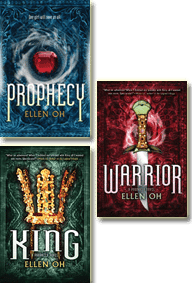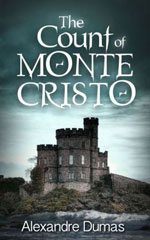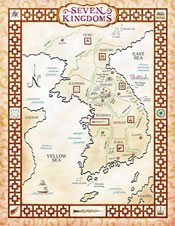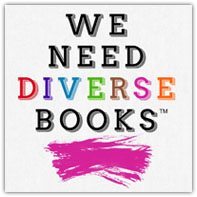 Bookologist’s note: Last month we featured Catherine, Called Birdy and an interview with the author, Karen Cushman. In that interview, nonfiction writer Claire Rudolf Murphy asked Cushman about her research and incorporation of historical fact into her fiction. Continuing that exploration, this month Bookology visits with novelist Ellen Oh. King, the final volume of her Prophecy trilogy, was released in March (volumes 1 and 2 are Prophecy, Harper Teen 2013 and Warrior, Harper Teen 2014). A blend of historical and fantasy fiction, the trilogy is set around 350 AD or CE and weaves ancient history from the area now known as Korea into a compelling and action-packed narrative about a teen girl, Kira, who is a demon-hunter and also the fulfilment of an ancient prophecy — the Dragon Musado who would unite the many divided kingdoms into a single nation.
Bookologist’s note: Last month we featured Catherine, Called Birdy and an interview with the author, Karen Cushman. In that interview, nonfiction writer Claire Rudolf Murphy asked Cushman about her research and incorporation of historical fact into her fiction. Continuing that exploration, this month Bookology visits with novelist Ellen Oh. King, the final volume of her Prophecy trilogy, was released in March (volumes 1 and 2 are Prophecy, Harper Teen 2013 and Warrior, Harper Teen 2014). A blend of historical and fantasy fiction, the trilogy is set around 350 AD or CE and weaves ancient history from the area now known as Korea into a compelling and action-packed narrative about a teen girl, Kira, who is a demon-hunter and also the fulfilment of an ancient prophecy — the Dragon Musado who would unite the many divided kingdoms into a single nation.
You have written on your website and spoken in other interviews about how your recreational reading of ancient Asian history triggered your writing. Have you always loved reading history and/or historical fiction?
 Yes. I love history. As a child my favorite books tended to be the historical ones. In fact, my all time favorite books were The Count of Monte Cristo and To Kill a Mockingbird. I was that nerdy kid that enjoyed reading the school history textbook. When I was 13, my parents got suckered into buying the entire World History Encyclopedia book set and I am not ashamed to admit that I read every single volume. And I read whatever interests me, which is how I got into Asian history. I was fascinated by the idea that Genghis Khan had been named Time’s Man of the Millenium and it led me to read everything I could get my hands on. And in the process, I learned all about Asian history and I was hooked.
Yes. I love history. As a child my favorite books tended to be the historical ones. In fact, my all time favorite books were The Count of Monte Cristo and To Kill a Mockingbird. I was that nerdy kid that enjoyed reading the school history textbook. When I was 13, my parents got suckered into buying the entire World History Encyclopedia book set and I am not ashamed to admit that I read every single volume. And I read whatever interests me, which is how I got into Asian history. I was fascinated by the idea that Genghis Khan had been named Time’s Man of the Millenium and it led me to read everything I could get my hands on. And in the process, I learned all about Asian history and I was hooked.
When you were first reading ancient Asian history, you must have encountered many things that rang the “how amazing—should be in a book!” bell. How did you keep track of those bits of history and mythology for later use?
Yes! So many awesome things. If the book was mine, I would tab all the important pages. But I had borrowed so many library books that I kept a notes journal filled with all the facts, legends, folktales, myths, etc., that I came across. I have several expandable file folders filled with papers and notebooks on all my notes.
Can you cite one or two finds that a reader will encounter in Prophecy or the later books?
The most amazing story I came across was the legend of the Rock of Falling Flowers, Nakhwa-am. Legend has it that during the Shilla and Tang invasion of Paekche in 638 C.E., 3,000 court ladies leapt to their deaths into the Baengma River. From a distance, the beautiful, multi-colored hanboks of the court ladies looked like falling flowers—which is where the place gets its name. The legend is so visually compelling that I knew I had to include it not only in my book, but also in my book trailer.
Can you cite one or two elements in the trilogy that would not show up in a history book?
Oh yeah, well it is a fantasy and I wanted the scary elements to be really creepy. So in Prophecy, you will come across demons that eat your organs and wear your skin like a Halloween costume. But the best part is Kira and her tiger spirit. Kira has yellow eyes because she has a tiger spirit that is part of her and protects her. And it is the tiger spirit that lets her see and smell demons, something that no one else in her world has.

You have a fabulous map on your website that shows the 7 Kingdoms from the novels. While you emphasize that your kingdoms are not the historical kingdoms that would merge into modern Korea, there is some similarity, and you list those. Geography is so important in the books—the mountains, the rivers, the seas, the location of the walled cities. How did you keep all of this clear in your head while writing?
I kept a copy of the map and a compass by my side the entire time I was writing. Especially in the latter books, where Kira has to literally zig zag her way across the country, I relied heavily on my map to course out the road she would travel.
Map-making can be a terrific writing prompt or exercise for uncovering details. Did you have any favorite writing exercises that helped you develop Kira’s character or world?
I like to use Excel spreadsheets and include all my characters in them and list out everything I know about them, even to their sordid and sometimes irrelevant backstories. But by putting together a spreadsheet, I was able to know intimately how everyone interacted with each other and why they were necessary in any given scene. It was, in a way, my character map.
Kira’s family gives loving support to her “differentness” and unique powers rather than cast her out or attempt to stifle her. Can you talk about that writer’s choice?
It was important for me that Kira had a strong family that she could fall back on. No matter how hard her life is, how hated she is by the outside world, having faith and being secure in her family’s love keeps her grounded. It is part of what develops her into such a strong character. And being a mom myself definitely played into this decision. You see, I have 3 wonderful and very different girls and it is important for me to be as supportive as I can for them. No matter what choices they make in life, I’ll always be there for them and love them unconditionally.
When you visit classrooms, what sort of questions do you get from students about the books?
The two most common questions are “Do you have a Jindo dog?” and “When will it be made into a movie?”
 You are the president of #WeNeedDiverseBooks. What’s ahead in the campaign for 2015?
You are the president of #WeNeedDiverseBooks. What’s ahead in the campaign for 2015?
So many great things! Our short story contest for a spot in our anthology is currently going on and we are getting a lot of amazing entries! We have begun awarding internship grants to increase diversity in publishing and we have opened up our Walter Awards for best diverse book. And we are gearing up to prepare for our Diversity festival which is currently set for July 2016 in Silver Spring, MD.
